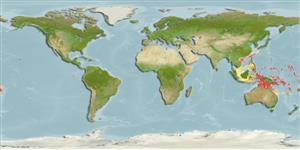>
Gobiiformes (Gobies) >
Gobiidae (Gobies) > Gobiinae
Etymology: Trimma: Greek, trimma, -atos = something crushed (Ref. 45335); preclarum: From the Latin word 'preclarus' meaning splendid ro very beautiful, referring to its color when alive, especially the multi-hued iris..
More on author: Winterbottom.
Environment: milieu / climate zone / depth range / distribution range
Ecología
marino asociado a arrecife; rango de profundidad 10 - 60 m (Ref. 90102). Tropical
Western Pacific: Fiji, Palau, Papua New Guinea, Solomon Is., and photographed underwater in Saipan.
Tamaño / Peso / Age
Maturity: Lm ? range ? - ? cm
Max length : 2.0 cm SL macho / no sexado; (Ref. 57544)
Espinas dorsales (total): 7; Radios blandos dorsales (total): 9; Espinas anales 1; Radios blandos anales: 8 - 9. Diagnosis: This species is characterized by the presence of predorsal scales; second and third dorsal-fin spines elongate; moderate interorbital and postorbital trenches; no opercular scales; and, scales across the top half of the body outlined with pigment. The fifth pelvic fin ray is branched sequentially once or unbranched depending on the capture location and living specimens has three yellow stripes extending along the body, two stripes in the dorsal and anal fins (one dark and one yellow) and a red or cerise iris with four large, irregularly-spaced yellow spot (Ref. 57544); characterized further by having longitudinal scale series 22-24; predorsal scales 6-9; depth of body about 4.2-4.4 in SL (Ref. 90102).
Collected from a drop-off wall with a few small caves, coralline algae, antipatherians and numerous hard corals (Ref. 57544). Inhabits reef walls and rubble in 10-60 m (Ref. 90102).
Life cycle and mating behavior
Madurez | Reproducción | Puesta | Huevos | Fecundidad | Larva
Winterbottom, R., 2006. Two new species of the gobiid fish Trimma from the coral reefs of the western Pacific Ocean (Pisces; Perciformes; Gobioidei). Zootaxa 1331:55-68. (Ref. 57544)
IUCN Red List Status (Ref. 130435)
Threat to humans
Harmless
Human uses
Más información
Nombres comunesSinónimosMetabolismoDespredadoresEcotoxicologíaReproducciónMadurezPuestaAgregación para la puestaFecundidadHuevosEgg development
ReferenciasAcuiculturaPerfil de acuiculturaRazasGenéticaElectrophoresesheritabilidadEnfermedadesProcesamientoNutrientsMass conversion
ColaboradoresImágenesStamps, Coins Misc.SonidosCiguateraVelocidadTipo de nataciónSuperficie branquialOtolitosCerebrosVisión
Herramientas
Special reports
Download XML
Fuentes de Internet
Estimates based on models
Preferred temperature (Ref.
123201): 26.1 - 28.9, mean 27.9 °C (based on 170 cells).
Phylogenetic diversity index (Ref.
82804): PD
50 = 0.5000 [Uniqueness, from 0.5 = low to 2.0 = high].
Bayesian length-weight: a=0.01023 (0.00477 - 0.02194), b=3.02 (2.84 - 3.20), in cm total length, based on LWR estimates for this (Sub)family-body shape (Ref.
93245).
Resiliencia (Ref.
120179): Alto, población duplicada en un tiempo mínimo inferior a 15 meses (Preliminary K or Fecundity.).
Fishing Vulnerability (Ref.
59153): Low vulnerability (10 of 100).
Nutrients (Ref.
124155): Calcium = 422 [175, 1,489] mg/100g; Iron = 1.96 [0.82, 4.41] mg/100g; Protein = 18 [16, 20] %; Omega3 = 0.183 [0.056, 0.600] g/100g; Selenium = 39.2 [11.2, 113.7] μg/100g; VitaminA = 107 [20, 547] μg/100g; Zinc = 4.93 [2.58, 8.37] mg/100g (wet weight);
